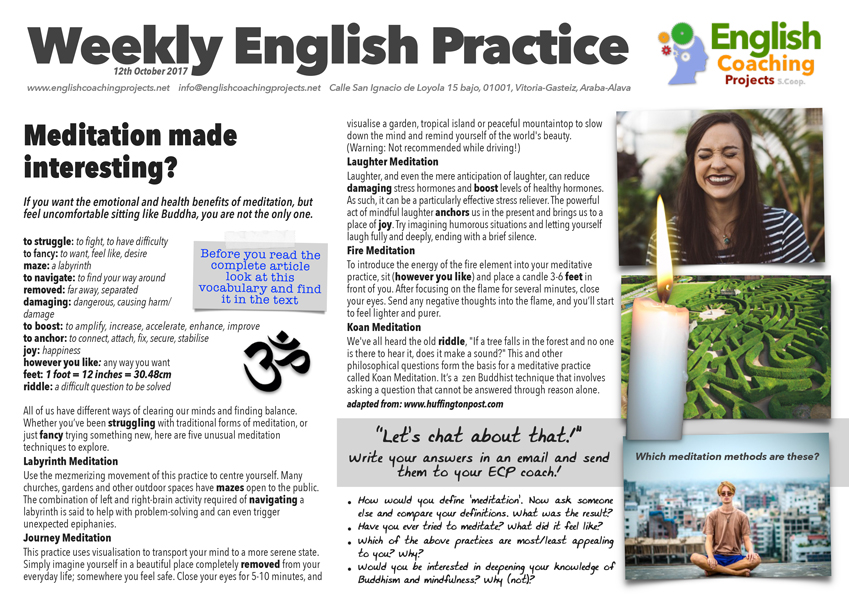Click on the image to download the pdf
If you want the emotional and health benefits of meditation, but feel uncomfortable sitting like Buddha, you are not the only one.
Vocabulary
Read and check you understand this before you read and listen to the article:
to struggle: to fight, to have difficulty
to fancy: to want, feel like, desire
maze: a labyrinth
to navigate: to find your way around
removed: far away, separated
damaging: dangerous, causing harm/damage
to boost: to amplify, increase, accelerate, enhance, improve
to anchor: to connect, attach, fix, secure, stabilise
joy: happiness
however you like: any way you want
feet: 1 foot = 12 inches = 30.48cm
riddle: a difficult question to be solved
All of us have different ways of clearing our minds and finding balance. Whether you’ve been struggling with traditional forms of meditation, or just fancy trying something new, here are five unusual meditation techniques to explore.
Labyrinth Meditation
Use the mezmerizing movement of this practice to centre yourself. Many churches, gardens and other outdoor spaces have mazes open to the public. The combination of left and right-brain activity required of navigating a labyrinth is said to help with problem-solving and can even trigger unexpected epiphanies.
Journey Meditation
This practice uses visualisation to transport your mind to a more serene state. Simply imagine yourself in a beautiful place completely removed from your everyday life; somewhere you feel safe. Close your eyes for 5-10 minutes, and visualise a garden, tropical island or peaceful mountaintop to slow down the mind and remind yourself of the world’s beauty. (Warning: Not recommended while driving!)
Laughter Meditation
Laughter, and even the mere anticipation of laughter, can reduce damaging stress hormones and boost levels of healthy hormones. As such, it can be a particularly effective stress reliever. The powerful act of mindful laughter anchors us in the present and brings us to a place of joy. Try imagining humorous situations and letting yourself laugh fully and deeply, ending with a brief silence.
Fire Meditation
To introduce the energy of the fire element into your meditative practice, sit (however you like) and place a candle 3-6 feet in front of you. After focusing on the flame for several minutes, close your eyes. Send any negative thoughts into the flame, and you’ll start to feel lighter and purer.
Koan Meditation
We’ve all heard the old riddle, “If a tree falls in the forest and no one is there to hear it, does it make a sound?” This and other philosophical questions form the basis for a meditative practice called Koan Meditation. It’s a zen Buddhist technique that involves asking a question that cannot be answered through reason alone.
“Let’s chat about that!”
Write your answers and send them by email to your ECP coach. Why not record your voice too? Listen to yourself speak and identify what you have to improve on ????
- How would you define ‘meditation’. Now ask someone else and compare your definitions. What was the result?
- Have you ever tried to meditate? What did it feel like?
- Which of the above practices are most/least appealing to you? Why?
- Would you be interested in deepening your knowledge of Buddhism and mindfulness? Why (not)?
Adapted from: www.huffingtonpost.com

